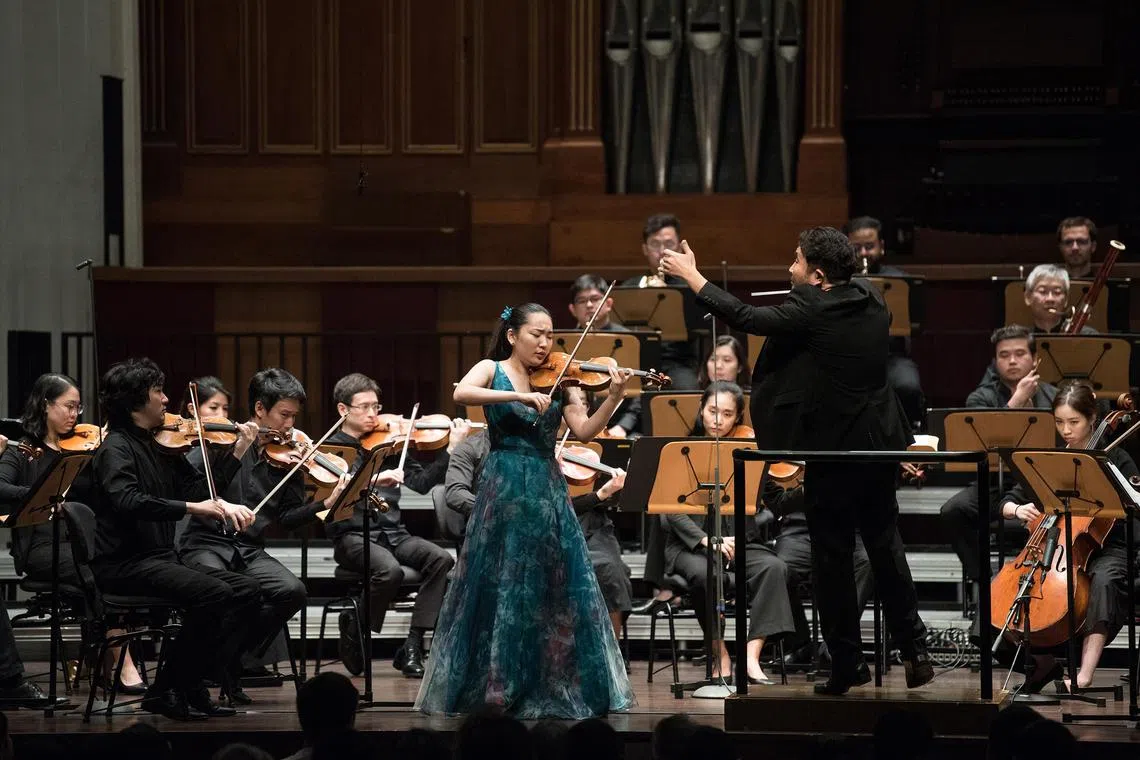Concert review: Artistic triumph of young American-Japanese violinist Keila Wakao
Sign up now: Get ST's newsletters delivered to your inbox

American-Japanese violinist Keila Wakao delivered a radiant yet mature performance at the re:Sound concert.
PHOTO: JACK YAM
Chang Tou Liang
Follow topic:
Keila Plays Barber
re:Sound
Victoria Concert Hall
Jan 15, 7.30 pm
The enduring popularity of music by 20th-century American composer Samuel Barber (1910-1981) rests on two works, and both were performed in re:Sound’s first concert of 2025. His Adagio For Strings, synonymous with grief and mourning, is an expanded orchestration of the central slow movement from the String Quartet Op.11.
Its overall mood of profound sadness is often milked for all its worth, diminishing its impact by cheapening it. However, the strings of re:Sound, led by concertmaster Yang Shuxiang, took a different view.
Adagio is not a matter of being slow, but possessing broadness in tempo. That was how the music emanated mysteriously from the ether, took on a slow burn all through to an impassioned climax, but without resorting to hysteria.
The sound was lush without being cloying, and the elegy was complete. Similar processes also dominated Felix Mendelssohn’s String Symphony No.7 In D Minor, composed when he was just 13. The performance of its four movements did not so much radiate youthful exuberance as the nous of a wizened veteran who knew his Mozart and Handel well.
The opening movement’s Sturm und Drang (storm and stress) was well handled, its urgency contrasted with the slow movement’s finely weaved romancing and third movement’s somewhat rough-hewn minuet.
All the stops were pulled out for the finale’s virtuoso show of fast and light playing, a typically Mendelssohnian trait, with the obligatory lesson of fugal counterpoint.
Back to Barber, his Violin Concerto (1939) received a radiant yet mature performance from 18-year-old American-Japanese violinist Keila Wakao, winner of the Yehudi Menuhin Violin Competition (Junior Division) in 2021, an accolade also bestowed on Singapore’s Chloe Chua. The concerto’s unusual schema of two slow movements followed by a brief but fiery fast finale to close was controversial during its time.
The original dedicatee balked at the “simplicity” of the first two movements but was defeated by the finale’s unbridled technical demands. All these played into the hands of Wakao, who was the very definition of virtuosity itself. Matching the might of the orchestra conducted by Lien Boon Hua, her performance was an unmitigated artistic triumph.
Beauty of tone and purity of intonation were evident from the outset, as she eased into the opening movement’s lyrical sweet spots. The orchestra could have overwhelmed her in the plethoric climaxes, but she stood tall and unflinching.
The central movement’s long orchestral introduction included a lovely solo from oboist Simon Lee (echoes of the slow movement from Johannes Brahms’ violin concerto) with further contributions from Ralph Lim’s clarinet and Alan Kartik’s French horn.
Then it was Wakao’s cue to turn on the charm, the music gently winding its way to powerful high points where she shone again.
The fearsome Presto In Moto Perpetuo finale held no terrors as both soloist and orchestra raced off to a breathlessly exciting finish. Wakao’s solo encore, the Dolce opening movement from Georg Philipp Telemann’s Fantasia No.7, was just sublime.

